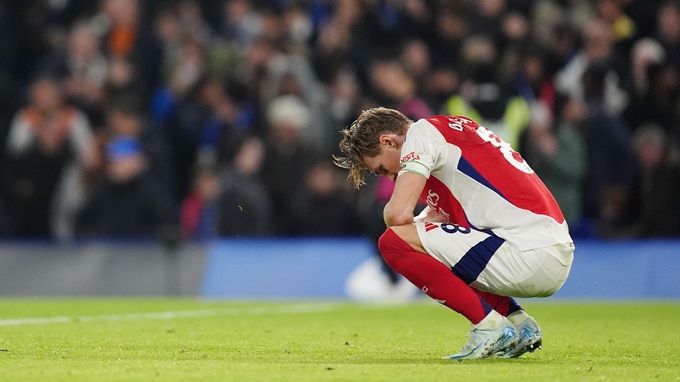With and without Martin Odegaard, Arsenal are two completely different teams. It’s not without reason that Mikel Arteta “prays for all players to stay healthy after every international break,” as Odegaard’s ankle injury could very well determine the Gunners’ season.
Arteta recently received both good and bad news regarding Odegaard. The good news is that the Norwegian midfielder returned in dazzling fashion with a convincing 90-minute performance against Chelsea. The bad news, however, came on the same day when national team coach Ståle Solbakken called Odegaard up to the Norway squad, even though Odegaard had been previously excluded due to injury. Arteta must be sitting on pins and needles because if Odegaard aggravates his ankle injury during the FIFA Days, Arsenal could be in the same difficult situation as they were over the past two months.
During that period, Arsenal won only 3 out of 7 Premier League matches, with a win rate of 42% when Odegaard was absent. However, when Odegaard was on the field, the team remained unbeaten in 4 matches (2 wins, 2 draws), with the win rate improving to 50%. While the difference in win rate might not seem significant, the actual difference on the field is enormous. Remember Odegaard’s assist for Gabriel Martinelli’s goal against Chelsea, a pass with just the right amount of power and height, completely bypassing the opposition’s defense and putting his teammate in a perfect position.

Under pressure from Chelsea’s defenders, Odegaard calmed himself for half a beat and curled the ball with the inside of his left foot, sending it precisely where it needed to go. No other player in Arsenal’s squad has that kind of passing ability. This was also Arsenal’s first goal from open play away from home since their match against Aston Villa in August, and their second away goal since their game against Manchester City in September. Odegaard’s presence is what brings life to Arsenal’s attacking third.
After 90 minutes, Odegaard created the most chances for Arsenal, while also controlling the most ball possession in the attacking third (3 times). What’s surprising is that Odegaard looked nothing like a player who had just recovered from a long-term injury. Arteta praised him: “I don’t know if there’s any other player who could perform at this level for 90 minutes after being out for 6 weeks with injury, having just one and a half days of training before the match. Odegaard’s physicality, rhythm, and mentality were incredible.”
Fairly speaking, Arsenal have played noticeably better with Odegaard on the field. However, looking across at Chelsea, the Blues still pose a significant threat, even though Cole Palmer had a subdued performance. Enzo Maresca has built Chelsea without relying on any one star. Arteta, of course, does not want Arsenal to depend on any single player, but the reality is that their play only truly takes shape when Odegaard is on the pitch.
This does not mean Odegaard will single-handedly put Arsenal back in the title race. No, Arsenal’s decline is a collective issue that no single player can fix. However, at least with Odegaard, there is a glimmer of hope. Arteta will continue praying for the fragile ankle of the Norwegian midfielder.

